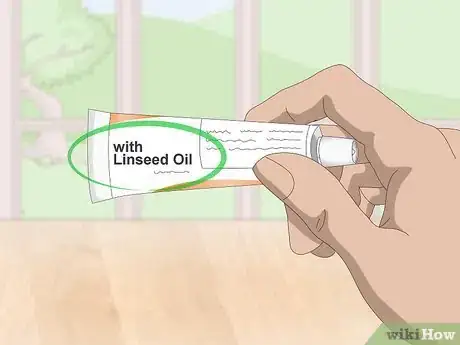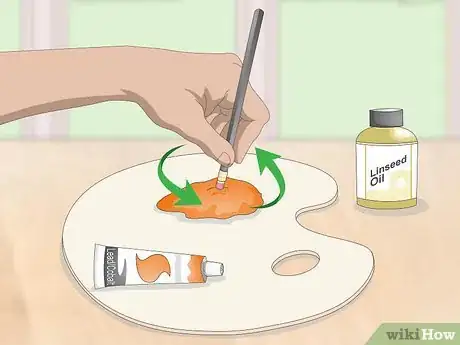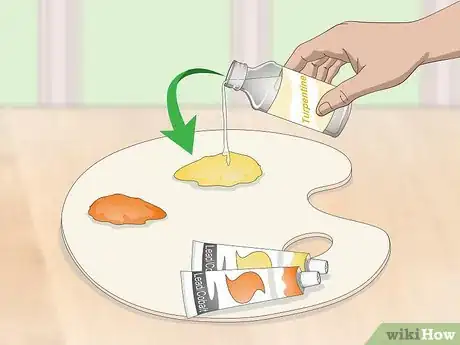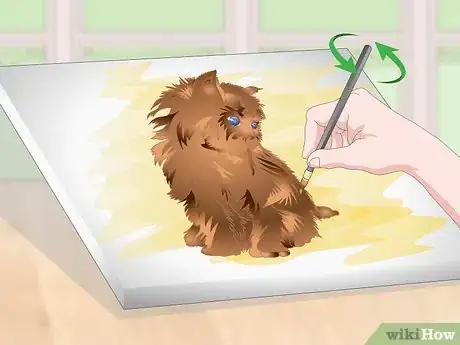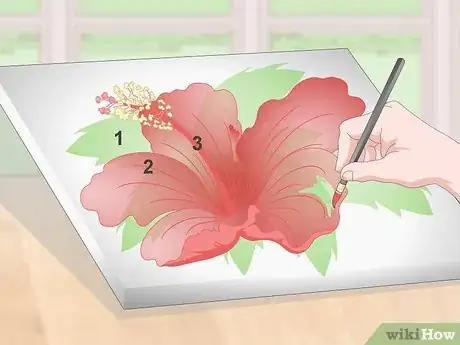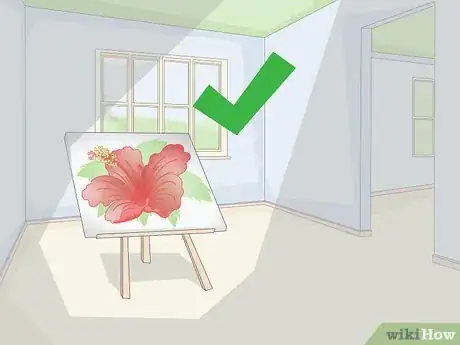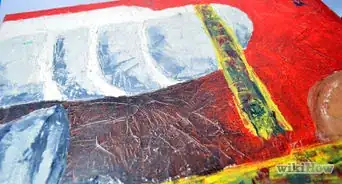This article was co-authored by Kelly Medford and by wikiHow staff writer, Amy Bobinger. Kelly Medford is an American painter based in Rome, Italy. She studied classical painting, drawing and printmaking both in the U.S. and in Italy. She works primarily en plein air on the streets of Rome, and also travels for private international collectors on commission. She founded Sketching Rome Tours in 2012 where she teaches sketchbook journaling to visitors of Rome. Kelly is a graduate of the Florence Academy of Art.
There are 8 references cited in this article, which can be found at the bottom of the page.
This article has been viewed 212,840 times.
Oil paint is a versatile medium that has been used since at least the 7th century A.D. to create beautiful works of art.[1] Oil paint is applied in layers to create the illusion of depth, but layers of oil paint can take days or even weeks to fully dry. Luckily, there are a few ways you can speed up the drying process.
Steps
Choosing Your Paint and Drying Mediums
-
1Use oil paints made from iron oxides for earth tones. Certain minerals used in oil paints dry faster than others. If you need to complete a painting in a short time frame, try using earth tones. Many earth colors use paints made from iron oxides, which can dry up to several days faster than other pigments.[2]
- Avoid using pigments like ivory black and cadmium, which tend to dry very slowly.
-
2Choose paints made with lead and cobalt for other hues. Pigments made from lead and cobalt are known to dry quickly. Using colors made from these metals can help speed the drying time of your painting.[3]Advertisement
-
3Look for paints made with linseed oil. The drying time of oil paints can vary based on the oil which was used. Linseed oil dries faster than walnut oil, which itself dries faster than poppy oil. Paints made from linseed oil can speed your painting's drying time significantly, and they're easily found at most art supply stores.[4]
-
4Seal the canvas with glue chalk gesso. Gesso is a primer that is applied to the canvas first to seal the canvas and prolong the life of the painting.[5] Glue chalk gesso is good for oil paintings because it will absorb some of the oil from the base layers, helping the painting to dry faster. Dip a primer or sponge brush into the gesso and apply it to the canvas in a thin layer. Allow it to dry thoroughly before moving on to oil paint.
-
5Combine linseed oil with the paint on your palette. Since linseed oil dries faster than other kinds of oil, mixing a little extra linseed oil with the paint on your palette can help speed the drying time of your painting.[6]
-
6Mix your paint with a solvent like turpentine or Liquin. There are a number of products available which are designed to thin oil paint and help it to dry faster. Turpentine is the most traditional drying medium, but alkyd mediums such as Liquin are also popular. Different solvents may produce slightly different textures to your paint, so experiment to see which one you prefer.[7]
- Solvents can be hazardous, so be sure to follow any label instructions and handle these products with care.
Applying the Oil Paint to Dry Faster
-
1Paint on a flat surface. When you paint on a textured canvas, the oil paint can build up in the crevices, creating a thicker layer that takes longer to dry. Look for a canvas with a smooth surface, or paint on another surface like a board.[8]
- If you're looking for a creative project that will still dry quickly, try applying oil paints to a copper pot. Oil paints oxidize more quickly on copper, although it will give a slightly green look to your painting.[9]
-
2Apply a base layer in a fast-drying paint. Using a fast-drying paint for your base layer can help all the rest of the painting dry more quickly as well. Paints containing metal irons like lead, cobalt, and copper tend to dry the fastest.[10]
- For example, if you're painting a desert landscape, you could use a paint made with red iron oxide as your background color.[11]
-
3Paint quickly using thin layers. Oil paint is best applied in layers, but if you apply a thick layer first, it can increase the drying time for each subsequent layer.[12] Instead, build up your painting from the thinnest layers to the thickest. For instance, if you have a cat in your painting and you want to use thick paint to make its fur look more realistic, you would apply that last.[13]
-
4Minimize the number of layers you use. If you're really on a time crunch and you need your painting to dry fast, choose a simple subject that you can paint by applying just a few thin washes, or layers, to your painting, with detail added in at the end. The more layers you apply, the longer the paint will need to oxidize.[14]
-
5Finish the painting with a heat gun. Heat guns can help bake the oils in your painting to help it to dry faster. However, if the heat is too high, the paint may crack or turn yellowish. For best results, keep your heat gun set to no more than 130 °F (54 °C).[15]
- Hold the heat gun a few inches away from the painting and move it slowly so the heat can penetrate the paints. The nozzle of the heat gun gets very hot, so be sure not to touch it or to allow it to touch the painting.[16]
Keeping Your Painting in the Right Environment
-
1Allow your painting to dry in a large, well-lit room with low humidity. Oil paints need time to oxidize, which is a process in which the paint reacts with air to harden. Other paints dry when the water in them evaporates, but oxidation is actually a change in the paint's chemistry. Oxidation best occurs in a room with plenty of natural light, low humidity, and good air circulation. [17]
-
2Use a dehumidifier if you live in a humid climate. Oil paint will oxidize faster in dry air. If you live in a humid climate, get a small dehumidifier and place it near your painting. This will remove excess humidity from the air, helping speed the drying time of the oil paint.[18]
-
3Circulate the air in the room with a fan. Pointing a fan at your oil painting won't help significantly speed the drying time in the same way as it would a watercolor painting, but having good circulation in the room will help the oxidation process to happen more quickly. This is because oils actually take oxygen from the air during oxidation, so circulating the air provides the paint with the oxygen it needs to dry. You can use either a box fan or a ceiling fan, and a low or medium setting should be adequate.[19]
-
4Keep the room warm. Oil paints dry faster in a warm atmosphere. The temperature in the room where your painting is drying should be at least 70 °F (21 °C), but the warmer you can get it, the better. Keep track of the temperature in the room by using a thermostat or by placing a digital thermometer near your painting.[20]
- There's not really a temperature that's too hot for oil paints, but try to keep the room as warm as you can while still keeping yourself comfortable.
Expert Q&A
-
QuestionHow long does it take for oil paint to dry?
 Kelly MedfordKelly Medford is an American painter based in Rome, Italy. She studied classical painting, drawing and printmaking both in the U.S. and in Italy. She works primarily en plein air on the streets of Rome, and also travels for private international collectors on commission. She founded Sketching Rome Tours in 2012 where she teaches sketchbook journaling to visitors of Rome. Kelly is a graduate of the Florence Academy of Art.
Kelly MedfordKelly Medford is an American painter based in Rome, Italy. She studied classical painting, drawing and printmaking both in the U.S. and in Italy. She works primarily en plein air on the streets of Rome, and also travels for private international collectors on commission. She founded Sketching Rome Tours in 2012 where she teaches sketchbook journaling to visitors of Rome. Kelly is a graduate of the Florence Academy of Art.
Professional Artist Oil paint dries from the top the topmost layer down, so it can stay wet for weeks at a time. Sometimes, oil paints won't fully cure until up to 6 months after you're finished.
Oil paint dries from the top the topmost layer down, so it can stay wet for weeks at a time. Sometimes, oil paints won't fully cure until up to 6 months after you're finished. -
QuestionCan I use acrylic paint as the base?
 Community AnswerYes; as a plastic-based paint, acrylic paint dries hard and dies hard.
Community AnswerYes; as a plastic-based paint, acrylic paint dries hard and dies hard. -
QuestionCan I use a hair dryer?
 Community AnswerYes. Just don't let it heat your paint too much.
Community AnswerYes. Just don't let it heat your paint too much.
References
- ↑ https://www.britannica.com/art/oil-painting
- ↑ https://www.si.edu/mci/english/research/technical_studies/drying_oils_paint.html
- ↑ https://www.si.edu/mci/english/research/technical_studies/drying_oils_paint.html
- ↑ https://arthearty.com/how-to-make-oil-paint-dry-faster
- ↑ Kelly Medford. Professional Artist. Expert Interview. 2 July 2019.
- ↑ http://www.artpromotivate.com/2012/11/how-to-speed-up-oil-paint-drying-time.html
- ↑ http://www.artpromotivate.com/2012/11/how-to-speed-up-oil-paint-drying-time.html
- ↑ http://www.artpromotivate.com/2012/11/how-to-speed-up-oil-paint-drying-time.html
- ↑ https://www.si.edu/mci/english/research/technical_studies/drying_oils_paint.html
- ↑ https://repository.si.edu/bitstream/handle/10088/20489/11.Tumosa.SCMC3.Mecklenburg.Web.pdf
- ↑ http://www.essentialchemicalindustry.org/materials-and-applications/paints.html
- ↑ Kelly Medford. Professional Artist. Expert Interview. 2 July 2019.
- ↑ https://arthearty.com/how-to-make-oil-paint-dry-faster
- ↑ http://www.artpromotivate.com/2012/11/how-to-speed-up-oil-paint-drying-time.html
- ↑ https://arthearty.com/how-to-make-oil-paint-dry-faster
- ↑ http://pictures.bountifulbaby.com/inventory/genesisgun.html
- ↑ https://www.si.edu/mci/english/research/technical_studies/drying_oils_paint.html
- ↑ http://www.artpromotivate.com/2012/11/how-to-speed-up-oil-paint-drying-time.html
- ↑ https://www.si.edu/mci/english/research/technical_studies/drying_oils_paint.html
- ↑ http://www.artpromotivate.com/2012/11/how-to-speed-up-oil-paint-drying-time.html
About This Article
If you want to create your own oil paintings, you can speed up the drying process by storing your painted canvas in a dry, warm room with plenty of light. If you live in a humid climate, consider using a dehumidifier in the room to help remove moisture from the air. You can also install a fan in the room to help keep the air circulating. Keep reading to learn how to select fast-drying oil paints and drying mediums to help your painting oxidize faster.


